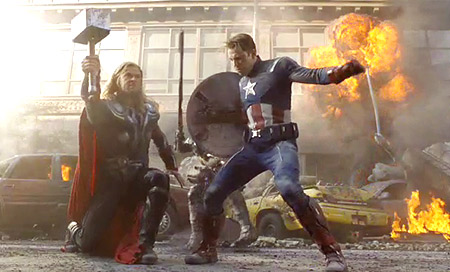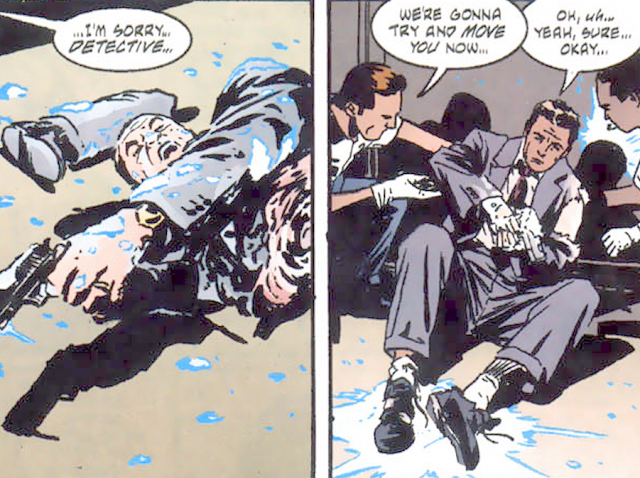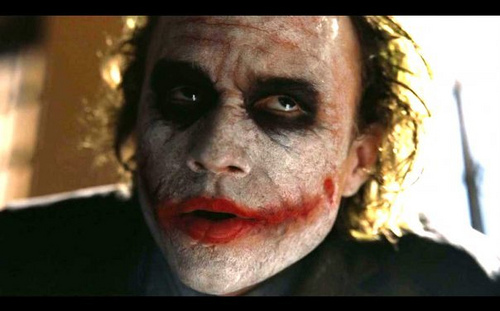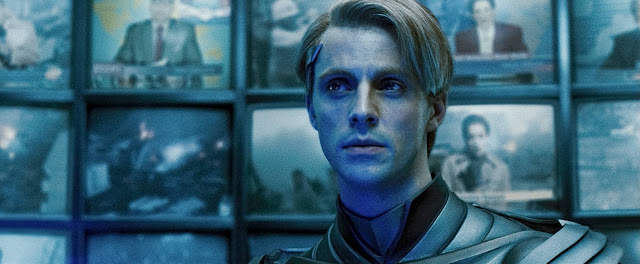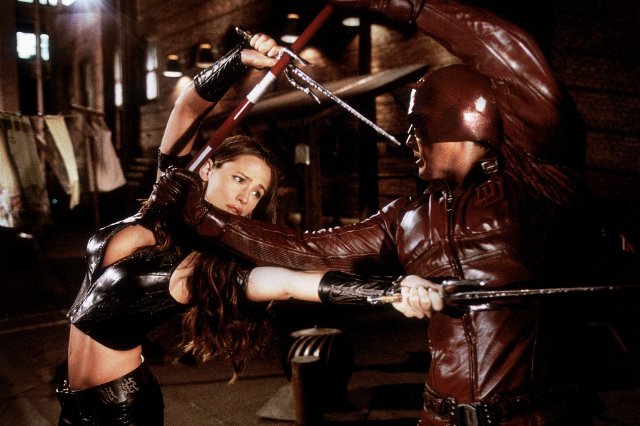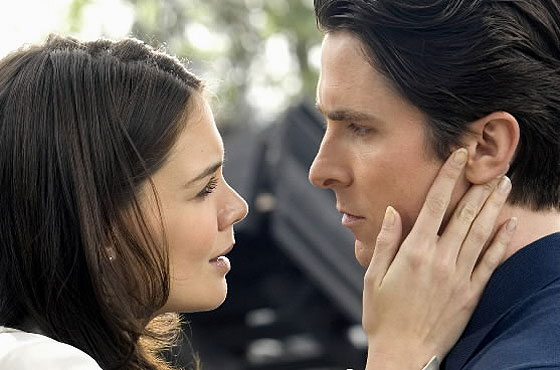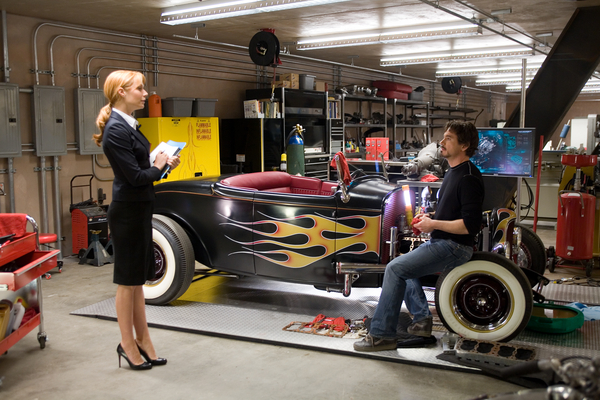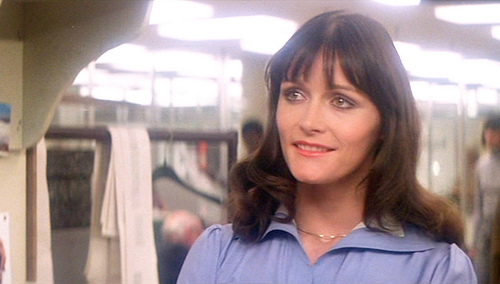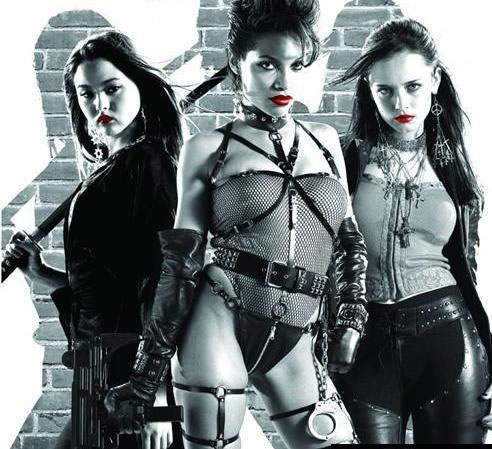The older I get, the harder it is to be
what I call a geek trouper, someone who can put in the extreme time
and effort that geeking out on stuff requires.
I think that’s part of
why geekdom feels like an eternal adolescence; who else has that much
time and emotional volatility to obsess over stuff without having to
worry about taxes and rent?
enjoyed attending a midnight screening of The Avengers last
week. And not only did I walk through the valley of geeks watching
Iron Man, Thor and Hulk smash things in the wee hours, but I drove
more than 200 miles to do it.
to handle in Philadelphia, and the same night we were traveling, a
bunch of dudes from our favorite comic book shop were seeing the
movie. Usually after a road trip I want a
sandwich and a nap, but a theater of teenagers and cosplayers would
have to do. I even wore my Thor T-shirt.
trouble, and then some! Perfect superhero film. Brilliant. Awesome.
Great pace and storytelling, sweet moments for each character. I even
liked the Joss Whedon touches: nerd jokes, killing off a likeable
character, witty banter and cult narratives.
the superhero movie, what am I looking for?
We’ve had a ton of supes
(and superhero-styled action pictures) on the screen now, and after
watching these things all my life, I have some basic rules.
glorious, yes? Whether light and true-blue righteous, or dark and
edgy, superheroes are modern gods going above and beyond us regular
folks. So they deserve some glamor. Decades of posed framework on the
printed page must translate to the screen, so give us those
awe-inspiring, iconic shots of our heroes doing what they do. This
isn’t the same as just having the hero stand around in their
underwear, Green Lantern and Barb Wire.
look the part. The Avengers has it in spades, especially in the
wraparound shot of the entire team as the alien army descends on
Manhattan, which each character taking one last move to prime their
weapons. It’s tougher with dark heroes, given that half the screen is
draped in shadow, but it can be done.
When you’ve got these superheroes driving their fists and feet and
knees into enemies, make it look good. Shoot the entire body so we
can see it work. You don’t watch a dance film just to see a flash of
shoulder, a fleck of feet, a shaped hand take the air. No. For
superheroes, the fight is their dance, and it must be exalted.
Christopher Nolan didn’t do this well in Batman Begins, and still
didn’t quite have the hang of it in The Dark Knight, but he got
better.
scary.
this is something many superhero movies miss out on. Comic books
filled with villains with mad schemes to take over the world are fine
there. Why does he want to take over the world? Because he’s evil.
Yeah, don’t need much more than that. Even villains who just like to
steal stuff work well in comics. But on screen, villains need to be a
real danger.
They need to threaten and menace the world you’ve
created, and they have to back it up. Comic book writer Ed Brubaker
made me realize that years ago with the first issue of Gotham
Central, when Mr. Freeze turns his freeze ray on a cop, then chisels
him apart.
plot to start World War III and mutant ascendency was fine, but it
was anchored in all the deaths he ordered as part of that plot, and
by sadistically shooting boy-Magneto’s mother before his eyes in a
Nazi concentration camp.
into the scariness. When Doctor Octopus marches off to die in
Spider-Man 2, it feels earned after watching his path of vengeance
and loss. It works after Sam Raimi already used his Evil Dead horror
tricks by making those mechanical arms pound the ground to announce
his arrival, sounding like the drums of hell.
in the Superman movies, too. These movies always played him as a
lucky swindler rather than the master criminal he boasted to be,
with bumbling henchmen and the stupid wigs. He’s gonna sink
California into the sea just to own beachfront property in Nevada?
And, even lamer, he’s gonna do the same crap in Superman Returns and
wipe out the Eastern seaboard just to have a vacation island, an
enterprise kickstarted by sexing an old lady to rip off her
inheritance? Just no.
best used the supervillain as terrorist.
The Joker is the most
real-world-scary supervillain we’ve seen despite covering his face in
clown paint. He menaces the entire film; even when he’s not on
screen, everyone’s trying to find out where he is and what he’s up
to. He puts his victims into horrific traps of conscience and death,
all for chaotic amusement and terror. I saw the movie with people who
covered their eyes whenever that tortured violin note started.
mask off.
identities. They need masks! Why would they keep taking the shit off
in front of supervillains who could find out who they are and kill
their families? Come on! Have you read Identity Crisis? (The
Justice League cartoon had the hilarious episode where Lex Luthor and
The Flash switched bodies, and Luthor pulls off the mask only to say,
“I have no idea who this is.”)
to signify some grand gesture or character development. But I also
know it’s so that your precious movie star has his face on screen.
Stallone wears the helmet for 10 minutes, and the rest of the movie
is him running around in a T-shirt. Guillermo del Toro has talked
about how studio execs looking at Hellboy wanted to make him a human
instead of a big red demon. Even the Captain America movie poster has
Chris Evans’ blond locks free; you’re taking a helmet off a soldier
in a war?
Spider-Man loses his mask while saving an El train full of people,
and the survivors pledge to keep his identity secret out of debt to
him. Or when Batman rips his mask off in Batman Returns in an
emotional plea for Catwoman to step off the edge of madness and
death. But for the most part, it’s Stallone running around in a
T-shirt or Ryan Reynolds’ silly mug in X-Men Origins: Wolverine.
Yuck.
details.
gets changed for a movie. I don’t, as long as it’s about details, not
about core parts of the character or story.
animals. Some stuff is too expensive or impractical, or sometimes it
just doesn’t look right because it wouldn’t feel real enough.
Superhero movies, like all movies, have to be real enough.
from the giant space monster to framing Dr. Manhattan worked great
for the Watchmen movie.
Alan Moore’s monster was fine in the comic
book’s historical analysis and deconstruction of superhero comic book
tropes. But on screen, you’d have had to add all this screen time
about the monster plot, the monster may have looked ridiculous
rendered in three-dimensional CGI, and the Dr. Manhattan choice was
tighter on a narrative level as well.
Reeves in LA? No.
don’t take yourself too seriously, either.
time. You can’t be silly about a superhero movie. Either you go big
and go all the way, or don’t bother trying. But take yourself too
seriously, and you become a joke. Hi, Superman III and Superman IV:
The Quest for Peace. What’s up, Daredevil and Elektra.
Thor; both Hayley Atwell and Natalie Portman’s characters felt
bolted-on. Hollywood studios still think this way with these movies;
put a woman in it, and some romance, and women’ll tolerate it when
their men drag them into the theater. People wanted to see Batman,
not him fawning over Katie Holmes.
superhero movies, which tend to be giant summer action blockbusters. Women like them because they’re people, and people like giant
summer action blockbusters. Women are going regardless of putting a
romance into the story where it doesn’t belong.
I talk to are much more interested in seeking Chris Evans’ torso than
worrying that he didn’t get that date at the end of Captain America.
I didn’t hear a single woman come out of The Avengers looking for a
love story; they preferred watching handsome men beat stuff up. It’s
OK.
the books, use it. Tony Stark and Pepper Potts in the Iron Man movies?
Sold. Peter Parker and Mary Jane Watson? Go get ’em, tiger. My
second-favorite scene in Spider-Man 2 is how the final shot isn’t
Spidey swinging off into the sunset, but MJ staring out that window with
the anxious look of what-happens-now.
human inside the super-suit.
movies, this is what really pulls the thing together. It’s why the
first half of Batman Begins, before Batman even shows up, it better
than the second half. It’s how Jon Favreau, an obvious gearhead,
spends so much time with Tony Stark in his lab building stuff. We get
to enjoy these super-humans as super-people. The Incredibles lived up to its name because of this principle.
This answers the why
question: Why do they become superheroes? As Rorschach says, “Because
we are compelled.” Green Lantern just gives Hal the ring, after
some brief psychobabble sketches of his character, and that’s it;
imagine if the film jumped right into him getting the ring, and then
him figuring out why he has it and why he personally must fight evil.
Whedon hit that next gear in Iron Man’s evolution; the previous
movies had him fighting for his own survival, of body and conscience,
but in The Avengers he is truly pushed to go beyond saving himself.
prevail, but if we know them before they struggle, and if we know why
they fight, then the payoff is so much higher.
tends to be. Most female characters in these movies are thrown in for
bolted-on romance, or they’re mothers-wives-girlfriends. Happens in
most movies with a male protagonist, which is most movies.
whiny-conscience plot devices. Think of Katie Holmes slapping Bruce
Wayne in the car; we don’t need more ridiculous scenes such as that.
was written and played pitch-perfect to the times of the mid-1970s
career woman who has spent years saying she doesn’t want a Superman,
she’ll go get it herself. Then she falls out of a building and
replies to Big Blue saying “I’ve got you” by shooting back,
“You’ve got me? Who’s got you?!?!” Brilliant.
up with warriors and fighters. If I made a superhero movie and was
writing the superhero’s woman, it would be worth talking to the wives
of soldiers, cops, firefighters, activists and reverends. Talk to the
people who choose to live with someone who puts their lives on the
line for something bigger, or who works in a dangerous job, or has
taken on a higher calling. Capture that sense of anxiety and danger
and backbone and grit.
those who fight and those who support. There definitely appears to
be something different about male warrior energy and female warrior
energy, and how the warrior woman navigates the man’s world.
rooted in the wife-mother-girlfriend mold. Sarah Connor and Ellen
Ripley paved the way for warrior women on film, but we don’t always
need for that toughness to spring from the maternal instinct as it
did for them. And I think Trinity in the Matrix films was compromised
by having to be The One’s woman.
women warriors; I don’t know how, but Robert Rodriguez just knew how
to shade those film noir-on-steroids depictions with sensibility. Just as Rodriguez does in the El Mariachi/Desperado films, he pairs the warrior man with the warrior woman. They are equal and fierce together.
The
Avengers‘ depiction of Black Widow is right up there, too. She played
assumptions of emotional weakness against her enemies while also
kicking their butts, but also had a brothers-in-arms camaraderie with
Hawkeye that you usually don’t see between a man and woman on screen.
more female screenwriters and directors. We need more than Rodriguez
and Joss Whedon for good warrior women on screen. Lori Alexander of Punisher: War Zone made a well-put together movie with a bad script and badder acting. Susanna White has helmed some sweet Boardwalk Empire episodes and worked on The Piano. Perhaps Lauren
Montgomery, who has done good work on the DC Animated direct-to-video
movies, will get a shot at live-action one day.
sequel to Hanna?
physical
oF super-powered folk. The Avengers‘ Hulk, for all his brawn and
mass, looked tangible and moved like a physical thing in actual
space, rather than the PlayStation 3-style special effects in the
second Hulk movie.
right now, and if DC Comics ever wants to enjoy Marvel’s type of
success with a line of interactive franchises, they have to nail this
one.
labor to fly, if we can’t feel the punch and feel like it would hurt,
the movie won’t work. Snyder has to show us that power with details and
camera angles than accentuate Superman’s physicality in the same way the gunfight movies show the rain of bullet casings. See the pavement
cracking, or glass shards from windowpanes shattering upon contact
with Kal-El’s skin. We have to see the muscles contract when he lifts
that car over his head.
dance.





































































































